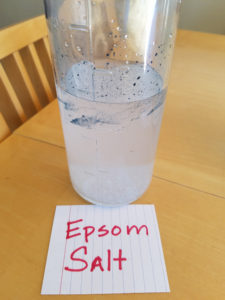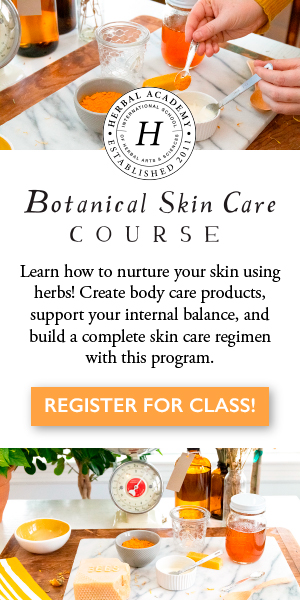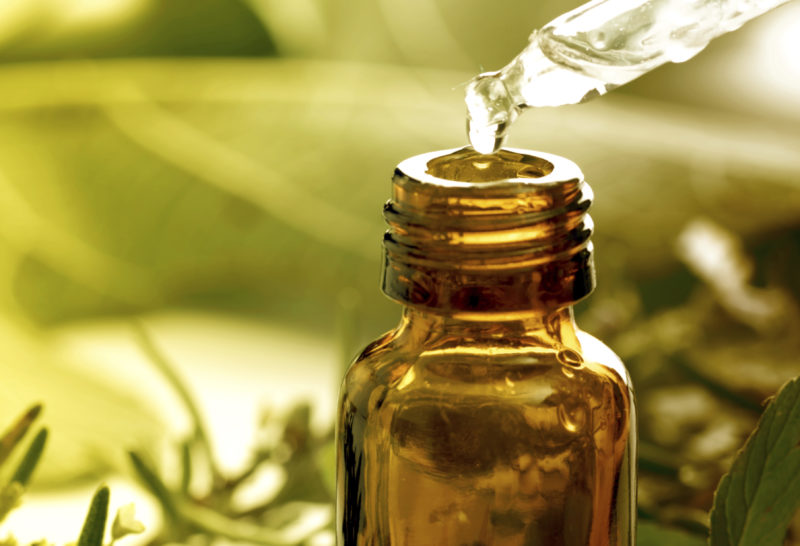
by Leslie Moldenauer | | Essential Oils
Aromatherapy is a gift for us all. All aromatherapists should look at you as the whole, unique, beautiful person that you are, not a set of symptoms. Homeostasis is the goal, finding balance, tapping into the body’s own innate healing ability. Herein lies the magic. –Leslie Moldenauer, CHNC, HHP, Cert. Aroma, Dipl. Aromatic Medicine
What in an essential oil?
Essential oils originate from many parts of a plant (Bark, flowers, leaves, roots, and stems), and are extracted through either steam-distillation, cold-pressing, or co2 extraction. Essential oils are the true essence of the plant and are highly concentrated extracts. The chemical composition and scent of these aromatics provide us with strong psychological and physical therapeutic benefit. Most of these benefits are seen through direct inhalation or applying diluted to the skin.
Essential oil Dilution
Essential oils very concentrated, many times over than the plant that it is derived from. Since they are so concentrated, they need to be diluted to avoid irritation for children and adults.
When using oils undiluted or what some call “neat” there are risks involved:
-The first risk is skin irritation, which is a direct result of contact with the skin and is localized to where the oil was applied. Once the material is removed, healing occurs. Removal is best done with a carrier oil such as almond, jojoba, or milk. Healing may not occur immediately, but you should see improvement after proper removal.
-The second, more serious reaction is a systemic (Affecting the entire body or organism) response involving the immune system called sensitization. According to Dorene Petersen of ACHS, “Sensitization occurs once the offending substance has penetrated the skin, been picked up by proteins in the skin, and mediated by the IgE response that produces histamine and other irritants” [1]. This is an allergic reaction that begins at the site of application but quickly spreads to the whole body. If the immune system response is activated, you likely will not be able to use the oil, or constituent in the oil again (the constituent can occur in multiple oils). If this happens to you please seek medical attention immediately. Please remember to always dilute before applying to the skin for your safety.
The Aromatic Wisdom Institute speaks in more detail about the topic of sensitization here [2].
Essential Oil Use and Children
Children are much more sensitive to essential oils and aromas in general, but when used with care they can still benefit from their therapeutic uses. There are a number of things that parents should know before using them to ensure the safety of their child.
Overall the immune system of a child is much more immature than that of an adult, therefore extra precautions need to be put in place. Newborn babies have an immature nervous system (blood/brain barrier), and liver. Therefore, avoiding the use of essential oils for a newborn (under 3 months) both via topical application and inhalation is probably best. In regards to the topical use of essential oils, many are not recommended dermally under two years of age per Robert Tisserand [3].
*For more information on what oils to avoid topically under two, please refer to Robert Tisserand’s latest book, Essential Oil Safety 2e.
My recommendation is, to begin with gentler remedies such as hydrosols (floral waters), homeopathy, and herbs for little children. These alone can be very beneficial. Reserve oil use for after trying these things first.
Essential Oil Diffusion
A great way to obtain the benefits of essential oils without the risk of skin irritation that topical use brings is by inhalation. There are a variety of methods of inhalation such as an aromastick, steam bowl, or even a drop on a cotton ball or tissue.
Essential oil diffusers disperse essential oil into the air in tiny droplets. There are a variety of diffuser available on the market. Here are a few that I own that you may want to take a look at:
Diffuser #1
Diffuser #2
Diffuser #3
(affiliate links)
I would recommend diffusing for periods of no longer than an hour without taking a break. In order to explain possible reasons for this, let’s talk a little bit about our sense of smell, or our olfactory system.
“Our sense of smell goes through five stages, those are: detect, transmit, perceive, analyze, and store. These stages cycle incredibly fast. The reception area of our olfactory system is called the olfactory epithelium. The olfactory epithelium is the size of a small postage stamp in each nostril and is packed with an impressive 40 million sensory neurons, capable of detecting .0000000013 of an ounce of a scent in a single breath of air” [4]. Our olfactory system is incredibly efficient, obtaining the therapeutic benefits of these amazing oils happens quickly. To receive maximum benefit and not waste your precious oils, follow the diffusing times recommended above.
Essential Oils and Pregnancy
Pregnancy is a delicate time, especially during the first trimester, and as we know that chemical constituents in essential oils pass the placenta, even though in minute amounts [5], safety is a genuine concern.
According to International Federation of Professional Aromatherapists (IFPA):
“Essential oils by their very nature, being organic substances, will cross the placental barrier and have the potential to affect the fetus. However, the amount of essential oil that actually accesses the mother’s skin is very tiny and therefore the amount that reaches the placenta is minuscule if proper dilutions are being used. Small amounts of essential oils can be beneficial to the baby and there are no recorded instances of harm being caused to the child through essential oils used in aromatherapy massage” (IFPA, 2013).
Aromatherapy, however, is rarely if ever black and white. It is not a NEVER or ALWAYS modality. Essential oils can be beneficial for pregnancy, labor, delivery, and postpartum. The key is knowing which oils to use, and how to use them.
If you are pregnant and are taking medications or have a medical condition, even more research needs to be done before using essential oils, as your list of “do not use” may be more detailed. Please seek out an aromatherapist for assistance.
If you are considered high risk due to multiple losses, it is advisable to restrict essential oil use during the first trimester. According to Robert Tisserand, due to the overall big picture of reproductive toxicity, topical application of essential oils while pregnant during any given day should not exceed a range of 1-4% [6].
Essential Oils and Phototoxicity
There are essential oils that cause phototoxicity or photosensitivity. This can occur when certain essential oil constituents on the skin react when exposed to the sun (ultraviolet light). This can result in general redness and burning of the skin, permanent changes in melanin, and chemical burns. These oils can be used on the skin, but utilize caution by not going out into the sun for 12-24 hours after exposure. This applies to the area of skin where the oil was applied, not your body as a whole.
Here is a list of oils that should be used topically with caution, and their maximum use levels according to IFRA standards [7]:
Angelica Root Angelica archangelica 0.8%
Bergamot Citrus bergamia 0.4%
Bitter Orange (Cold/Expeller Pressed) Citrus aurantium 1.25%
Cumin Cuminum cyminum 0.4%
Grapefruit (expressed) Citrus paradisi 4.0%
Lemon (Cold/Expeller Pressed) Citrus limon 2.0%
Lime (Cold/Expeller Pressed) Citrus aurantifolia 0.7%
Mandarin Leaf Citrus reticulate 0.17%
Rue Ruta graveolens 0.15%
Taget Tagetes minuta 0.01%
Always use extreme caution when using any of these oils topically. It can be assumed that if someone is taking moderate amounts of a phototoxic oil internally that a phototoxic reaction can occur. If you use any of these oils, utilize caution.
In conclusion
Essential oils are potent; it is crucial that you keep them out of reach of children. I have seen pictures online of small babies or small children handling bottles of oil. It is not cute, nor safe to let them hold them. Your children should know from a very young age that essential oils are medicine, and not for their little hands.
Essential oils are a beautiful modality and I am grateful to have access to them. When you follow proper safety guidelines, you can utilize essential oils and know that you are doing the best for yourself and your family.
References
[1] [4] American College of Healthcare Sciences (2012) Aroma 101
[2] Essential Oil Sensitization. Retrieved from
Would You Know If You Had an Essential Oil “Sensitization” Reaction?
[3] [5] [6] Tisserand, R., Young, R. (2014) Essential Oil Safety (2nd Ed)
[7] IFRA standards. Retrieved from http://www.ifraorg.org/en-us/standards-library/s/phototoxicity#.V9VaSpMrJn4


BEFORE YOU GO! Remember to sign up for my FREE Facebook group! Hang out with me and THOUSANDS of other Essential Oil lovers looking to learn, click on to join Real Essential Oil Education Group!
Check out my FREE offer below!
Like so many practices in life, I encourage you to become educated on the proper use of essential oils. When using them, please do so cautiously, understanding that there is often misinformation on the internet. You can be assured that I support only educated and proven resources. While essential oils should not be feared they should be respected and used properly to ensure the safety of the individuals using them.
Please note that I am not a medical practitioner. The content of this website is provided for general informational purposes only and is not intended as, nor should it be considered a substitute for, professional medical advice. Do not use the information on this website for diagnosing or treating any medical or health condition. If you have or suspect you have a medical problem, promptly contact your professional healthcare provider. By using this website, you assume full responsibility and liability for your own actions.
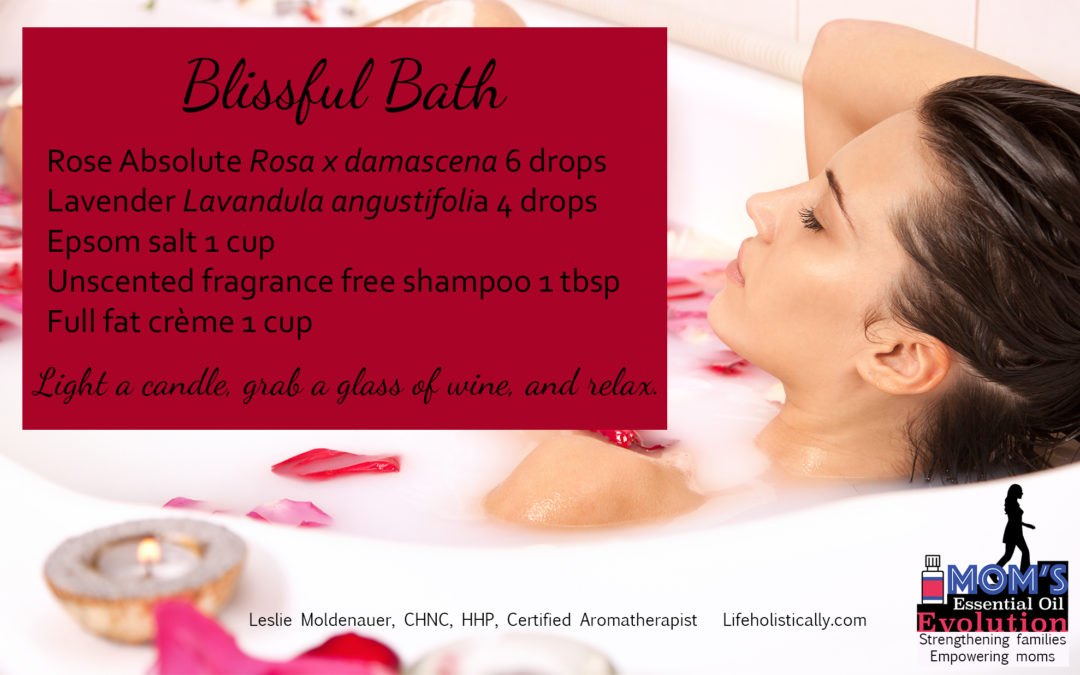
by Leslie Moldenauer | | Essential Oils
Proper use of essential oils in the bath. Not only are the specific oils used in the bath of great importance, safety needs to be considered in how you add them as well. For example, use peppermint with great caution as it can be a very “eye-opening” experience, and bergamot is a very strong photosensitizing oil, the bath is simply not the “best” place for its use.
There are many bloggers that recommend adding essential oils to (only) Epsom salts for a calming bath experience. This is not recommended. In order to cover why that is, let’s talk just a moment about chemistry.
Essential oils are not soluble in water. Essential oils are lipophilic (fat-loving), also called non-polar substances (but they are not actually fats). In contrast, Epsom salts or sea salt hydrophilic (water-loving), also called a polar substance. As a general rule, polar substances will dissolve in polar solvents and non-polar substances will dissolve in non-polar solvents. This confirms the fact that water and oil do not mix.
One option is adding your essential oil to carrier oil before stepping in. This is an option, and it does avoid neat application on the skin (never recommended). So if you are in a pinch you can use a carrier oil.
Alas, there is a better way!
A surfactant is used to properly disperse essential oils in the bath. A surfactant is something that will cause two substances that do not easily mix together (oil and water), to chemically bond and remain mixed. A surfactant’s job is “connecting” the two together.
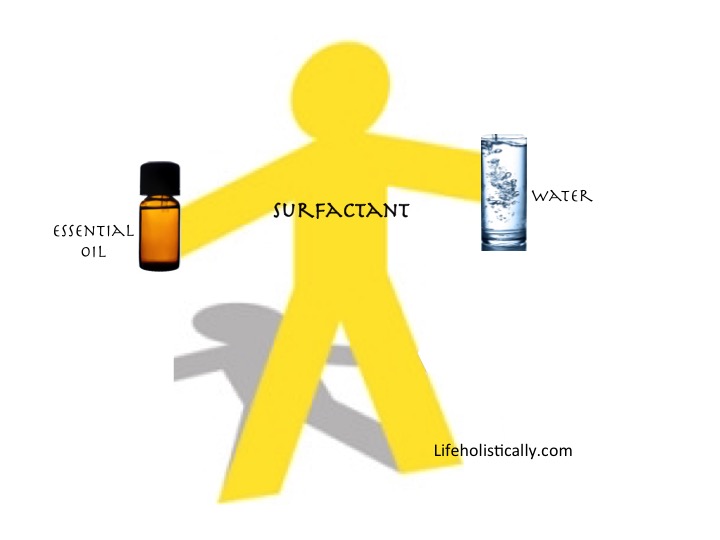
Soap, for example, has a chemical structure that is attracted to water on one end and attracted to oil on the other. Castile soap, shampoo, or bubble bath is very effective. Another option is a product called Solubol, it can work beautifully to mix oil and water, but I prefer to use fragrance-free shampoo.
I performed an experiment recently to show how essential oils dissolve in water and varying substances. Let’s take a look!
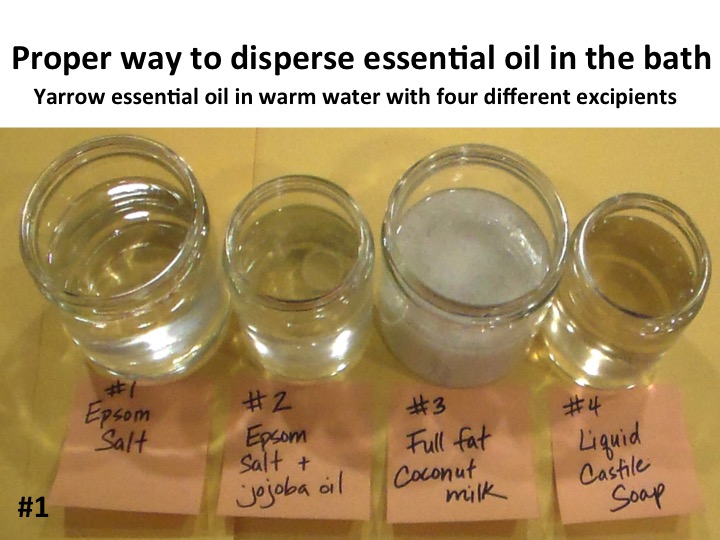
I used yarrow essential oil for its blue color. I used very warm water in all 4 containers. I thoroughly mixed the containers, multiple times, and let them settle.
My mixes are as indicated in image #1 are:
#1-Epsom salts (2 tbsp) 4 drops eo
#2-Epsom salts (2 tbsp) and jojoba oil (1 tbsp) 4 drops eo
#3-Full fat coconut milk (2 tbsp) 4 drops eo
#4-Liquid castile soap (2 tbsp) 4 drops eo
The results?
#1 was the worst of the 4. All of the oil sat on the very top of the water.
#2 the essential oil and carrier oil mixed together well, to then sit on the top of the water. (Better than #1 or neat use, but still not the best).
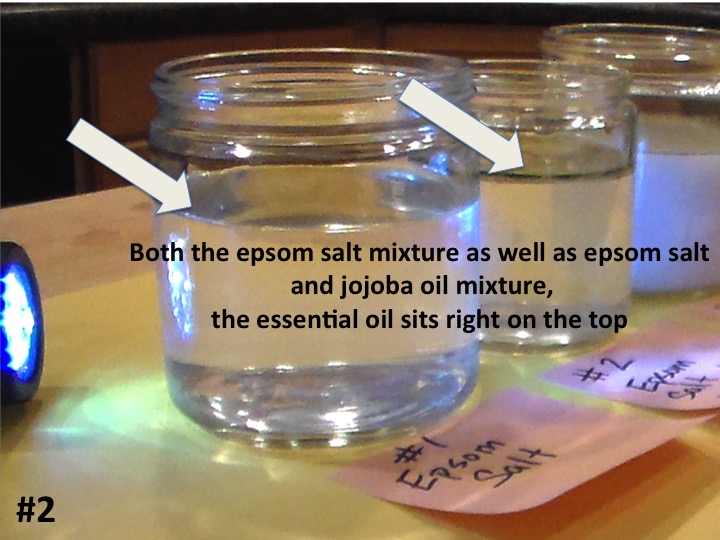
#3 was average at best. The image is not perfect because you can not see through the glass, but there are small droplets throughout the container, with many large droplets still sitting on the top. (Check the top of this container in image #1, you can see the droplets.
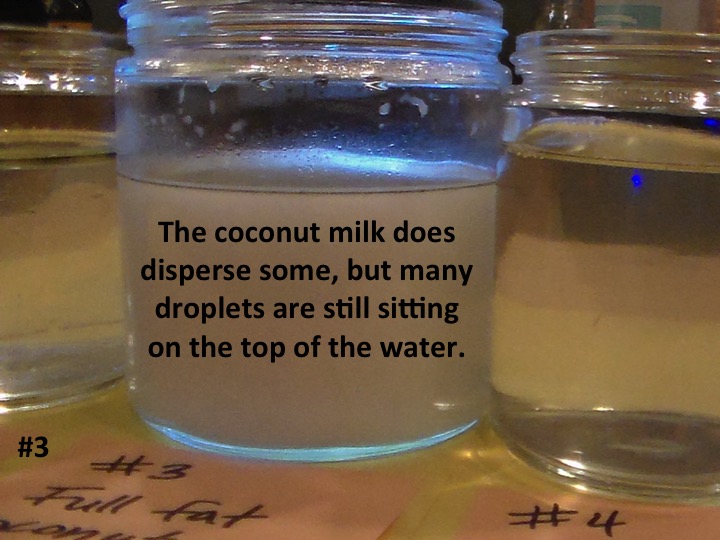
#4 and winner, liquid castile soap. It mixed rather well, no droplets on top, or within the container.
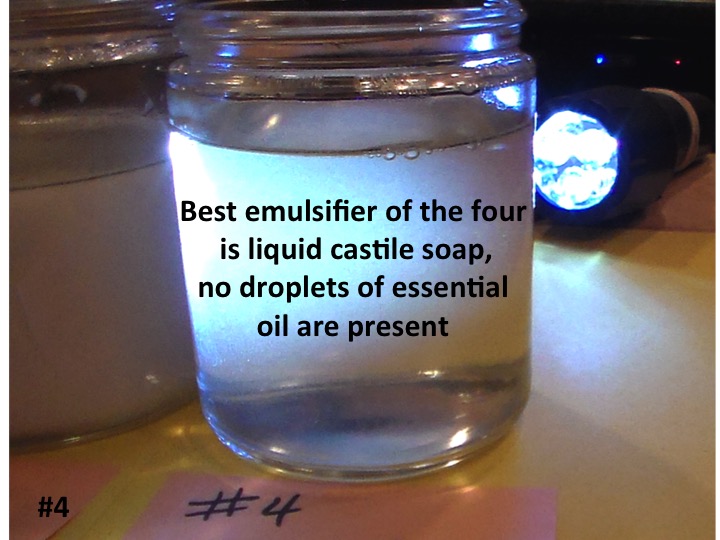
Of the 4 excipients, liquid castile soap is your best bet to fully disburse your essential oils in the bath. Some say liquid castile soap is drying….I have a solution!
I am a fan of Epsom salts for their muscle relaxing properties (magnesium), and carrier oil for softening the skin, so here is a blend I typically use for myself:
In a container I mix well:
1 cup Epsom salts
1 tbsp skin nourishing carrier oil
1 tbsp Dr. Bronner’s liquid castile soap or fragrance-free shampoo (You will likely find the shampoo to be the better choice)
3-6 drops essential oil (Depending on whether you are bathing yourself or a child)
***12/1/2016 UPDATES***READ ME IN FULL
I wanted to share an important update. I have had some state that they get an unpleasant clumping effect when using castile soap. It was never clear, however, the brand that they used. Yesterday, I decided to treat myself to an aromatic bath, and used a product I had never tried before, “Aloe vera Castile shower gel”. The result? Awful clumping! Lesson learned. Make note that I have never had this result with Dr. Bronner’s brand Castile soap…..but cannot guarantee another brand will not clump. Shampoo, however, has never failed me!
This will not be a recipe that you can make ahead of time for gifting. If you want to make it, keep the dry and wet ingredients separate and sent instructions with the gift. A little more legwork, but necessary to avoid clumping and molding.
****A great option for the bath, and especially bath bombs is Natrasorb. Read about it here.
Here are a few new images from my most recent experiment (12/13/2016). I had someone suggest fractionated coconut oil dispersed well, so I added it to the mix. See images below.
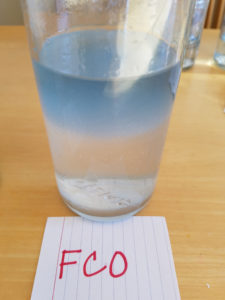
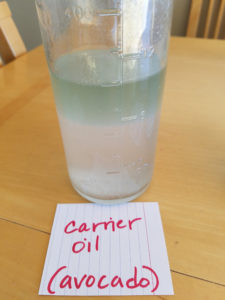
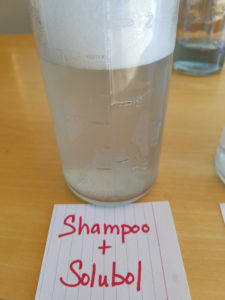
As you can see, FCO and German chamomile in warm water do not disperse. Neither does Epsom salt or any other carrier oil. The last image of shampoo/solubol is ideal. It is important to note that carrier oil is “OK” as far as it eliminates “neat” oil in the bath, and can be used in a pinch. It does not however properly disperse, so everything will sit on top of the water, no water how much you mix it. Epsom salt alone is essentially neat oil, no matter what you read on the Internet. Happy soaking!

Like so many practices in life I encourage you to become educated on the proper use of essential oils. When using them, please do so cautiously, understanding that there is often misinformation on the internet. You can be assured that I support only educated and proven resources. While essential oils should not be feared they should be respected and used properly to ensure the safety of the individuals using them.
Please note that I am not a medical practitioner. The content of this website is provided for general informational purposes only and is not intended as, nor should it be considered a substitute for, professional medical advice. Do not use the information on this website for diagnosing or treating any medical or health condition. If you have or suspect you have a medical problem, promptly contact your professional healthcare provider. By using this website, you assume full responsibility and liability for your own actions.
Witch Hazel (Hamamelis virginiana)-Uses and Limitations
Do Epsom Salts Really Work?

by Leslie Moldenauer | | Essential Oils
I have had so many messages lately about general confusion surrounding essential oil use for children. Is it safe? Is it dangerous? Somewhere in between?
Children are much more sensitive to essential oils and aromas in general, but they can also benefit greatly from their therapeutic uses. There are a number of things that parents need to know before using them to ensure the safety of their child. Looking up a blend or recipe online is not the best way to use your oils. Let’s cover a few things that you may or may not already know in order to keep your little ones safe.
Overall the immune system of a child is much more immature than that of an adult, therefore they are much less likely to be able to handle adverse reactions, even diffusing for long periods can be overwhelming to them. Keep in mind that until a child reaches the age of 5, on average (from experience) they are not going to be able to express that they are feeling “off” if you are diffusing an anti-germ blend of too long in the home, as one example.
What we do know is that babies have an immature nervous system, integumentary system, and liver.
*Rather than me just telling you this and you take it at face value, PLEASE, I encourage you to read further on these topics from these references in which I came to my findings above:
*Tisserand, R., Young, R. (2014) Essential Oil Safety (2nd Ed) Elsevier: London, UK. (p47)
*Leung, A., Balaju, S., Keswani, S., (2013) Biology and Function of Fetal and Pediatric Skin.
21(1): 1-6. Retrieved from https://www.ncbi.nlm.nih.gov/pmc/articles/PMC3654382/
*Eye and Vision Development. Retrieved from
http://www.healthofchildren.com/E-F/Eye-and-Vision-Development.html
*Nervous System Development (2014) Retrieved from
https://www.thevisualmd.com/health_centers/child_health/infant_nutrition/
nervous_system_development
In light of all of this, avoiding the use of essential oils for infants and babies under a few months of age both via topical application and inhalation is probably best. Work with/ask a qualified aromatherapist for more information. In regards to topical use of essential oils, many are not recommended dermally under two years of age. This does NOT, however, equate to never use essential oils under two, a bit of a misunderstanding of Tisserand’s most recent book published in 2014.
Diffusing Essential Oils
So if topical use is not the best way for a young child, what is? Inhalation is the ideal method of use for young children. This does not mean however that you should turn on the diffuser and leave it on all day. I do not recommend diffusing for longer than a period of one hour without taking a break for older children, in line with Tisserand’s recommendations. Younger children can benefit from a conservative 10-20 minutes before taking a break. In order to explain possible reasons for this, let’s talk a little bit about our sense of smell, or our olfactory system.
Through my courses at the American College of Healthcare Sciences I learned that, “Our sense of smell goes through five stages, those are: detect, transmit, perceive, analyze, and store. These stages cycle incredibly fast. The reception area of our olfactory system is called the olfactory epithelium. The olfactory epithelium is the size of a small postage stamp in each nostril, and is packed with an impressive 40 million sensory neurons, capable of detecting .0000000013 of an ounce of a scent in a single breath of air” (ACHS, Aroma 101).
Mind-boggling isn’t it! Our olfactory system is so incredibly efficient, that obtaining the therapeutic benefits of these amazing oils happens quickly. Certain oils are stronger than others as well and can be overwhelming diffused for long periods of time, therefore always be sure to diffuse in a well-ventilated room. To receive maximum benefit and not waste your precious oils, diffuse around small children for short periods of time as mentioned above. Please make note, nebulizers are very different than diffusers. Nebulizers are MUCH stronger than your average diffuser. In this instance, I do not recommend following the times listed above, it would be much too aggressive of a treatment.
Topical Application
You can begin to apply oils topically over the age of two, but dilution amounts are very important. Never use oils topically undiluted, or what some call “neat”. This greatly increases your risk for skin irritation and skin sensitization. Contrary to what you may have been told, skin irritation is not a detox reaction.
(See more details here in an article written by Kristina Bauer a.k.a. The Untamed Alchemist)
Special Considerations
If your child suffers from epilepsy, asthma, an autoimmune disorder, or cancer, you should contact a qualified aromatherapist. Not all oils will cause the same reactions for everyone; please do not navigate this for yourself. (Always let your doctors know that you are utilizing aromatherapy for your children. Same goes for herbs, homeopathy, etc.)
Essential oils are potent, it is crucial that you keep them out of reach of children. I have seen pictures online of small babies or small children handling bottles of oil. It is not cute, nor safe to let them hold them. Your children should know from a very young age that essential oils are medicine, and not for their little hands.
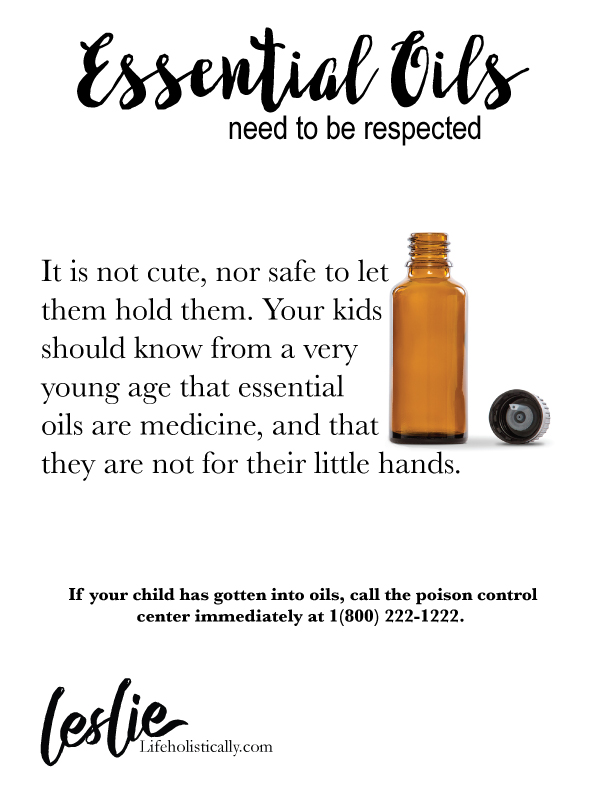
Now being an aromatherapist, I certainly do not want to discourage you from using essential oils with your children. I use the following methods on my boys and have for years (now 7 and 9): topically, in a diffuser, in a steam tent, in an aromastick, in a bath, a lotion, a salve, and more. We have some go to oils for supporting a good night’s rest, ones that bring support to the respiratory system when the need arises, help with bumps and bruises, ones that bring comfort, and oils that provide overall support to their bodies own innate healing process.
You will find camps of people that say never use essential oils on children, and others who throw caution to the wind and say that all oils are safe to use on children. My beliefs are not in line with either camp. Essential oils are not an always or never modality. When you follow proper safety guidelines, you can utilize essential oils and know that you are doing the best for your children.

Like so many practices in life I encourage you to become educated on the proper use of essential oils. When using them, please do so cautiously, understanding that there is often misinformation on the internet. You can be assured that I support only educated and proven resources. While essential oils should not be feared they should be respected and used properly to ensure the safety of the individuals using them.
Please note that I am not a medical practitioner. The content of this website is provided for general informational purposes only and is not intended as, nor should it be considered a substitute for, professional medical advice. Do not use the information on this website for diagnosing or treating any medical or health condition. If you have or suspect you have a medical problem, promptly contact your professional healthcare provider. By using this website, you assume full responsibility and liability for your own actions.
References and Resources
https://www.aromaceuticals.com/blog/adverse-reactions-to-peppermint-oil
http://www.aromaweb.com/articles/diffu.asp
http://tisserandinstitute.org/essential-oils-and-the-detox-theory/
http://wegotreal.com/essential-oil-concerns-robert-tisserand/
http://roberttisserand.com/2014/05/essential-oil-dilution-important/
http://www.aromahead.com/blog/2009/08/02/essential-oil-chemistry-oils-high-in-18-cineole/
American College of Healthcare Sciences (2012) Aroma 101 (p 185)
Tisserand, R., Young, R. (2014) Essential Oil Safety (2nd Ed) Elsevier: London, UK. (p47)
Leung, A., Balaju, S., Keswani, S., (2013) Biology and Function of Fetal and Pediatric Skin.
21(1): 1-6. Retrieved from https://www.ncbi.nlm.nih.gov/pmc/articles/PMC3654382/
Eye and Vision Development. Retrieved from
http://www.healthofchildren.com/E-F/Eye-and-Vision-Development.html
Nervous System Development (2014) Retrieved from
https://www.thevisualmd.com/health_centers/child_health/infant_nutrition/
nervous_system_development
BEFORE YOU GO! Remember to sign up for my FREE Facebook group! Hang out with me and THOUSANDS of other Essential Oil lovers looking to learn, click on to join Real Essential Oil Education Group!
Check out my FREE offer below!











